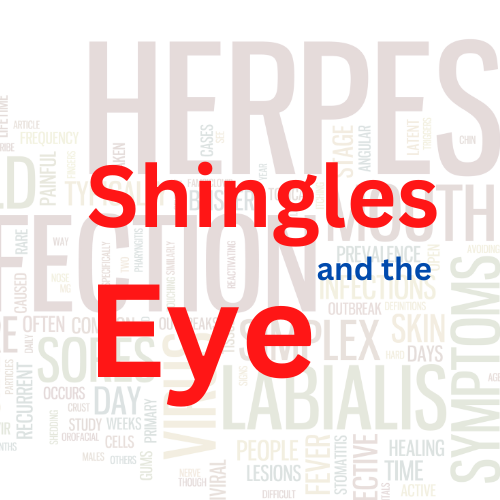Shingles and your eye
Shingles is caused by the reactivation of the virus that causes chickenpox—varicella zoster virus. After chickenpox resolves the virus lives on throughout the body in the nerve fibers, but the virus is kept dormant by the immune system.
Any process that weakens the immune system in a person who has had chickenpox increases that person’s risk for developing shingles. Processes that can weaken the immune system are illness, aging, and taking immune-suppressing medications.
About 20% of those who develop a case of shingles have shingles in the nerves of the head. In those cases, the shingles infection can affect the eyelids, internal structures of the eye, the forehead, and the nose.


Pain is usually the first symptom of shingles and depending on the location of the shingles, the pain can be mistaken for problems with the heart, lungs, or kidneys.
There is commonly a shingles rash that appears as a stripe of blisters. Sometimes the blisters occur around one eye or on one side of the neck or face. The shingles virus travels along a nerve path and the rash will often form a line. Some people with shingles do not have a visible rash.
If left untreated, severe cases of shingles of the eye can cause corneal scarring and permanent eye damage.
Symptoms of shingles in the eye
- Pain in your eye
- Redness, tearing, or watery eyes
- Blurry vision
- Extreme sensitivity to light
- Swelling of the eyelid
If you have one or more of these symptoms, make an appointment to see your primary care doctor or your eye doctor. The sooner treatment is started the less likely there will be long-term complications.
Shingles in the back of the eye
Shingles in the retina or optic nerve are not usually associated with a skin rash or other symptoms of the eye surface. This type of shingles is called viral retinitis and it is much less common than shingles around the outer part of the eye. Shingles in the back of the eye can significantly damage the retina through infection and inflammation.
Treatments
Antiviral medications such as acyclovir, famciclovir, and valacyclovir can slow down the progress of shingles if they are taken within the first 72 hours of the appearance of symptoms. Antiviral treatment also reduces the overall severity of the infection and the risk of post-herpetic neuralgia which is a form of long-term pain that can occur repeatedly after a bout of shingles.
Sometimes the inflammation associated with shingles of the eye is so severe that steroids are needed to control the inflammation before it damages the eye.
Mild cases of shingles in the back of the eye can be treated with oral antiviral medications, with or without injections of antiviral medications into the eye. In more severe cases, or if there is no improvement with oral medications and intraocular injections, the shingles infection is treated with intravenous (IV) antiviral medications until the infection starts to improve.
See an ophthalmologist
If your shingles involve your upper face such as your forehead or scalp area, it is important to see an ophthalmologist for a comprehensive eye exam. Keratitis, an inflammation of the cornea, can develop a month after shingles symptoms appear and can cause cornea scarring that can lead to blindness.
Best protection from shingles is the shingles vaccine
The best way to prevent shingles is by getting the shingles vaccine—Shingrix. The vaccine is administered in two doses and it is more than 90% effective at preventing shingles. The vaccine will not treat shingles. It is only effective as a preventative strategy.
Gregory Scimeca, M.D.
Ophthalmologist and Medical Director
The Eye Professionals
Our Locations
